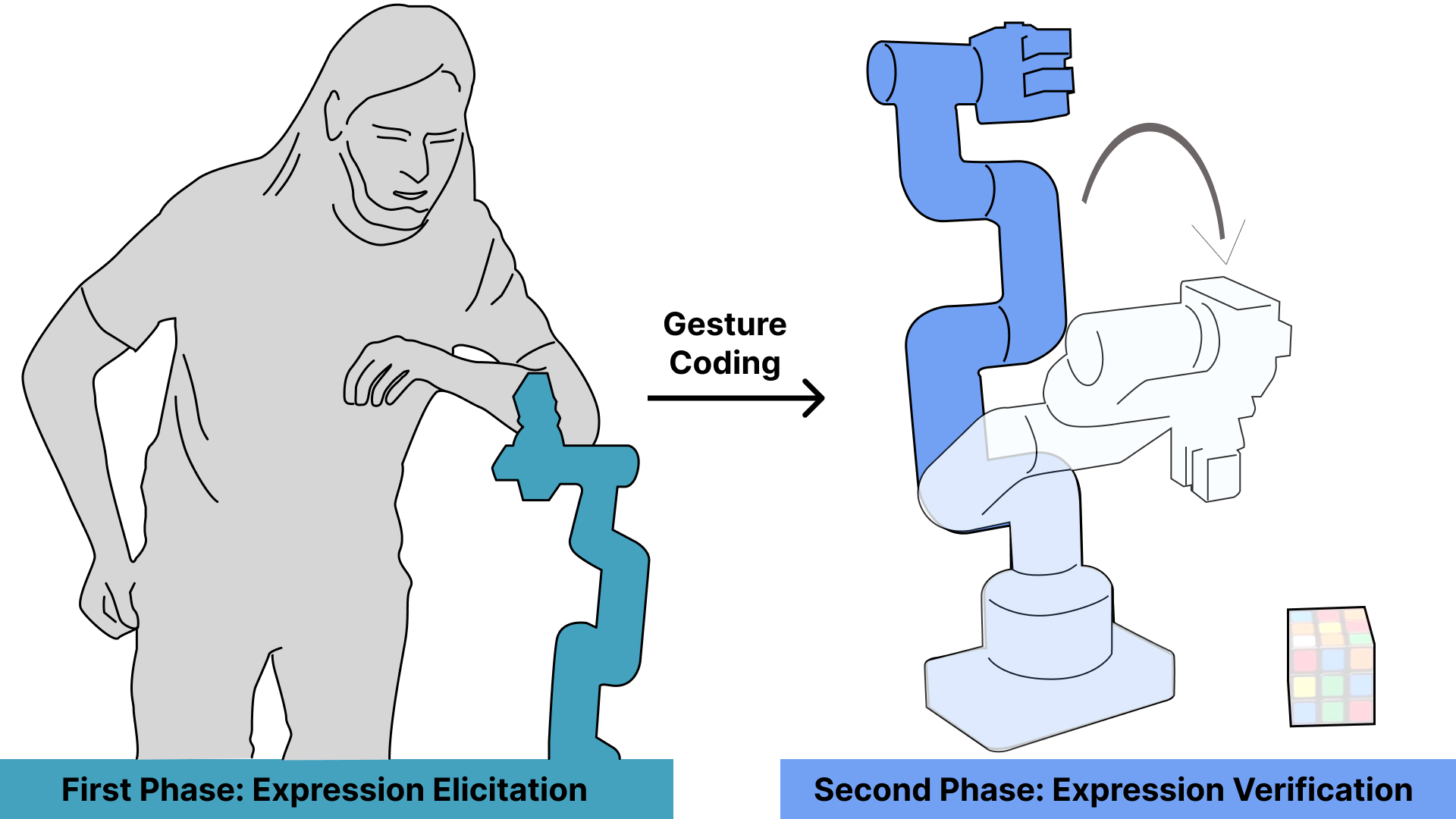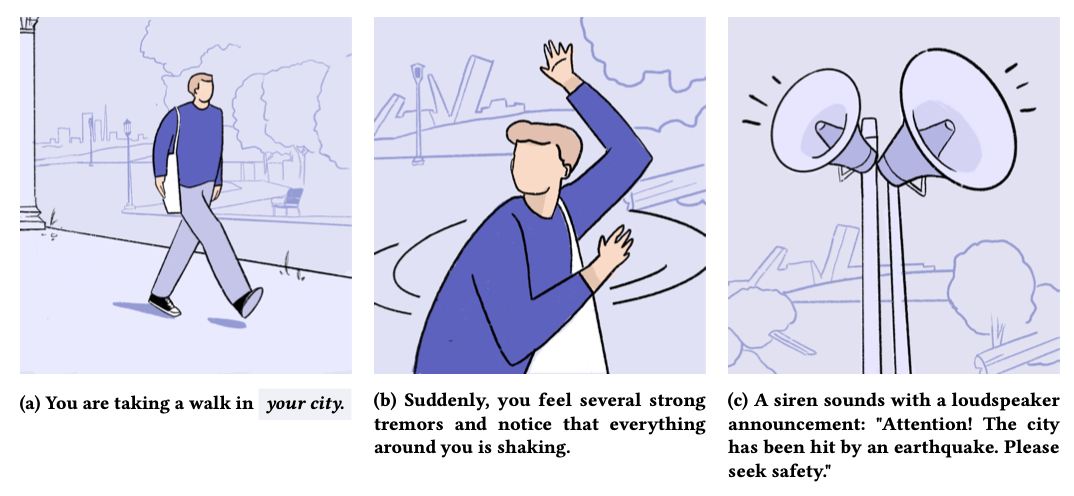We are in the process of curating a list of this year’s publications — including links to social media, lab websites, and supplemental material. Currently, we have 65 full papers, 22 LBWs, three Journal papers, one alt.chi paper, two SIG, two Case Studies, one Interactivity, one Student Game Competition, and we lead two workshops. 13 papers received an honorable mention.
Disclaimer: This list is not complete yet; the DOIs might not be working yet.
Your publication from 2025 is missing? Please enter the details in this Google Forms and send us an email that you added a publication: contact@germanhci.de
An Approach to Elicit Human-Understandable Robot Expressions to Support Human-Robot Interaction
Jan Leusmann (LMU Munich), Steeven Villa (LMU Munich), Thomas Liang (University of Illinois Urbana-Champaign, LMU Munich), Chao Wang (Honda Research Institute Europe), Albrecht Schmidt (LMU Munich), Sven Mayer (LMU Munich)
Abstract | Tags: Full Paper, Understanding People | Links:
@inproceedings{Leusmann2025ApproachElicit,
title = {An Approach to Elicit Human-Understandable Robot Expressions to Support Human-Robot Interaction},
author = {Jan Leusmann (LMU Munich), Steeven Villa (LMU Munich), Thomas Liang (University of Illinois Urbana-Champaign, LMU Munich), Chao Wang (Honda Research Institute Europe), Albrecht Schmidt (LMU Munich), Sven Mayer (LMU Munich)},
url = {https://www.medien.ifi.lmu.de/, website https://www.linkedin.com/company/lmu-media-informatics-group/posts/?feedView=all, lab\'s linkedin
https://www.linkedin.com/in/jan-leusmann/, author\'s linkedin},
doi = {10.1145/3706598.3713085},
year = {2025},
date = {2025-04-26},
urldate = {2025-04-26},
abstract = {Understanding the intentions of robots is essential for natural and seamless human-robot collaboration. Ensuring that robots have means for non-verbal communication is a basis for intuitive and implicit interaction. For this, we describe an approach to elicit and design human-understandable robot expressions. We outline the approach in the context of non-humanoid robots. We paired human mimicking and enactment with research from gesture elicitation in two phases: first, to elicit expressions, and second, to ensure they are understandable. We present an example application through two studies (N=16 & N=260) of our approach to elicit expressions for a simple 6-DoF robotic arm. We show that the approach enabled us to design robot expressions that signal curiosity and interest in getting attention. Our main contribution is an approach to generate and validate understandable expressions for robots, enabling more natural human-robot interaction.},
keywords = {Full Paper, Understanding People},
pubstate = {published},
tppubtype = {inproceedings}
}
Curious Shorts: Curiosity-Driven Exploration and Learning on Short-Form Video Platforms
Felicia Fang-Yi Tan (National University of Singapore), Ashwin Ram (Saarland University), Moritz A. Messerschmidt (National University of Singapore), Hasini A. Dissanayake (National University of Singapore), Suranga Nanayakkara (National University of Singapore)
Abstract | Tags: Full Paper, Understanding People | Links:
@inproceedings{Tan2025CuriousShorts,
title = {Curious Shorts: Curiosity-Driven Exploration and Learning on Short-Form Video Platforms},
author = {Felicia Fang-Yi Tan (National University of Singapore), Ashwin Ram (Saarland University), Moritz A. Messerschmidt (National University of Singapore), Hasini A. Dissanayake (National University of Singapore), Suranga Nanayakkara (National University of Singapore)},
url = {https://hci.cs.uni-saarland.de/, website },
doi = {10.1145/3706598.3713951},
year = {2025},
date = {2025-04-26},
urldate = {2025-04-26},
abstract = {Short-form video platforms like YouTube Shorts captivate users with engaging content, but their potential for promoting incidental learning remains underexplored. We present Curious Shorts, a conceptual framework that extends the Hook Model, designed to enhance curiosity-driven exploration and incidental learning on these platforms. In Study 1, we empirically tested two designs that incorporate "curiosity nudges" — interactive prompts that spark curiosity and encourage further exploration — with follow-up videos to satisfy that curiosity. Results show that specific, question-driven prompts proved most effective, significantly boosting curiosity and encouraging more focused and intentional viewing compared to the baseline. Study 2 examined whether this design enhances incidental learning without compromising engagement. Findings confirmed improved learning outcomes. However, when applied to a realistic viewing environment interspersed with entertainment videos, engagement remained high while learning benefits diminished. We conclude with implications for balancing learning and engagement on short-form video platforms and propose directions for future research.},
keywords = {Full Paper, Understanding People},
pubstate = {published},
tppubtype = {inproceedings}
}
The User Perspective on Island-Ready 6G Communication: A Survey of Future Smartphone Usage in Crisis-Struck Areas with Local Cellular Connectivity
Leon Janzen (Secure Mobile Networking Lab, TU Darmstadt), Florentin Putz (Secure Mobile Networking Lab, TU Darmstadt), Marc-André Kaufhold (Science, Technology for Peace, Security, TU Darmstadt), Kolja Straub (Secure Mobile Networking Lab, TU Darmstadt), Matthias Hollick (Secure Mobile Networking Lab, TU Darmstadt)
Honorable MentionAbstract | Tags: Full Paper, Honorable Mention, Understanding People | Links:
@inproceedings{Janzen2025UserPerspective,
title = {The User Perspective on Island-Ready 6G Communication: A Survey of Future Smartphone Usage in Crisis-Struck Areas with Local Cellular Connectivity},
author = {Leon Janzen (Secure Mobile Networking Lab, TU Darmstadt), Florentin Putz (Secure Mobile Networking Lab, TU Darmstadt), Marc-André Kaufhold (Science and Technology for Peace and Security, TU Darmstadt), Kolja Straub (Secure Mobile Networking Lab, TU Darmstadt), Matthias Hollick (Secure Mobile Networking Lab, TU Darmstadt)},
url = {https://www.seemoo.tu-darmstadt.de, website
https://www.linkedin.com/in/leon-janzen-071134194/, linkedin},
doi = {10.1145/3706598.3714324},
year = {2025},
date = {2025-04-26},
urldate = {2025-04-26},
abstract = {Using smartphone apps during crises is well-established, proving critical for crisis response. However, such apps become useless without an Internet connection, which is a common issue during crises. The ongoing 6G standardization explores the capability to provide local connectivity for cities cut off from the outside Internet in crises. This paper introduces the concept of local cellular connectivity in isolated cities to the HCI community. It presents findings from a survey (N = 857) of users in Germany’s major cities on their smartphone usage preferences in this connectivity model. Results show a shift in app demand, with citizens favoring everyday apps over dedicated crisis apps in certain scenarios. We further prioritize smartphone services based on their criticality, distinguishing between apps essential for crisis response and those supporting routine. Our findings provide insights for operators and developers in making user-centric design decisions during the realization of local connectivity in isolated cities.},
keywords = {Full Paper, Honorable Mention, Understanding People},
pubstate = {published},
tppubtype = {inproceedings}
}

